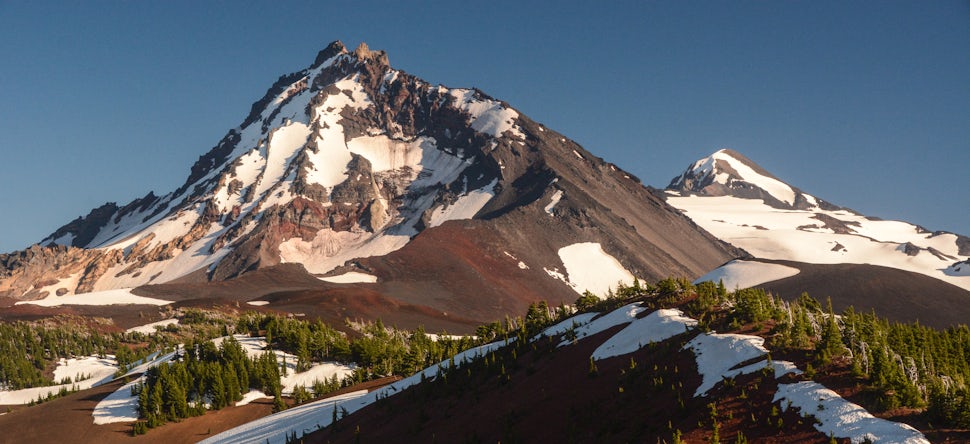The Wonder That Surrounds Oregon's Yapoah Crater
An afternoon north of the Three Sisters

Some of the youngest rock in Oregon sits on the boundaries of the Deschutes and Willamette National Forests near McKenzie Pass. About 2,000 years ago, lava flowed from a vent just north of North Sister and created a black, jumbled, and barren landscape. Since then, the surrounding forest has regained little ground. A few hemlocks and white bark pines have found places for roots, but the flow remains largely unvegetated. The Pacific Crest Trail winds its way alongside and through the lava, and hikers following it south from McKenzie Pass soon encounter the source of the flow: Yapoah Crater.
There it is, up ahead. A flash of movement along the forest floor. I’m ten minutes into this hike and here is a species I’ve only seen twice before. At first, it looks like a large squirrel, but in a gap between the trunks I gain clarity and properly identify the furry blur: it’s a pine marten. He’s way too fast for photos, and the other folks heading towards me on the trail give him no further incentive to stick around among a growing crowd of humans. They don’t see him, though, as he bounds away. I’ve followed marten tracks in the snow plenty of times, but the snow is gone here and so is he. I had high hopes for this evening adventure. With a start like this, they’ve been elevated.
I am on the Pacific Crest Trail, walking south through the Three Sisters Wilderness towards its namesakes. Up on this ridge above North Matthieu Lake, the forest of hemlock and pine has opened up and the snowy peaks of the Cascades are in view once again. Wind whips over the divide, but the sun’s heat balances it out as I admire lupines blooming among the rocks. Fields of lava spread out before me and cling tight to the patches of snow that still linger among their folds. It really has not been long since this landscape was moving and pulsing with volcanic energy. The barren jumbles of basalt attest to the short interlude between their solidification and today. It will be centuries before a forest reclaims this territory. That’s fine with me: the view is magnificent.
I’ve left the PCT in favor of this user trail and now stand atop Yapoah Crater. That name, Yapoah, is a native term for an isolated hill. True, this cinder cone stands on its own in the immediate vicinity, but I would contend that it is far from isolated. Surveying the scene from the crater rim, the neighboring summits seem close enough to touch and numerous enough to fill my mind with daydreams of the views that they might offer. To the north, I can see Black Crater, Washington, Three Fingered Jack, Jefferson, Hood, and Adams. To the south sit Collier Cone, North Sister, and Middle Sister. Maybe Yapoah is isolated, but it’s far from lonely.
North Sister looks magnificent today. Reds, tans, and grays mingle in layers exposed by the snow and ice that still cover parts of the volcano. My view from the north looks straight into the cirque of the Linn Glacier, the river of ice that has scoured away the northern face of the mountain once called “Faith.” The Linn is one of a dozen glaciers that emanate from the four high peaks of this wilderness. That tally was once seventeen, but by some definitions there are now five fewer glaciers and five more snowfields and ice masses; warming trends have shrunk and stalled the former ice rivers. Even with a tally of a twelve, that still means I’m peering into the largest concentration of glaciers this far south in the United States. There are lonesome glaciers down in the Sierras and southern Cascades, but this family of volcanos continues to provide a home for a dwindling family of glaciers.
Golden hour light washes over the landscape as I halfheartedly hike back towards the trailhead. I want to stay, but will have to settle for a return. In a month, perhaps, the snow will have receded, the wildflowers will bloom in the meadows below the Three Sisters, and the high ridges and peaks will be even more inviting than they are now. The trail points me north, straight towards distant Mt. Jefferson. What lies in those forests and snowfields? I entertain the thought momentarily, but yank myself back to this lava flow south of Scott Pass. There is more than enough natural beauty to contemplate here. Penstemon line the rocky trail, shadows lengthen in the hemlocks, and I name the birds as I hear the evening songs they sing from hidden branches. It is beyond grand to be right here, right now.
We want to acknowledge and thank the past, present, and future generations of all Native Nations and Indigenous Peoples whose ancestral lands we travel, explore, and play on. Always practice Leave No Trace ethics on your adventures and follow local regulations. Please explore responsibly!
Do you love the outdoors?
Yep, us too. That's why we send you the best local adventures, stories, and expert advice, right to your inbox.












